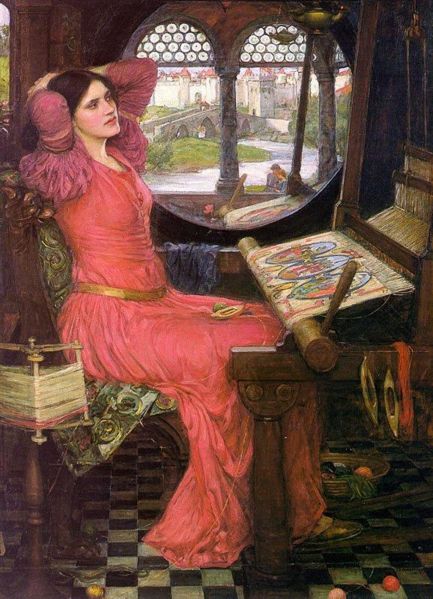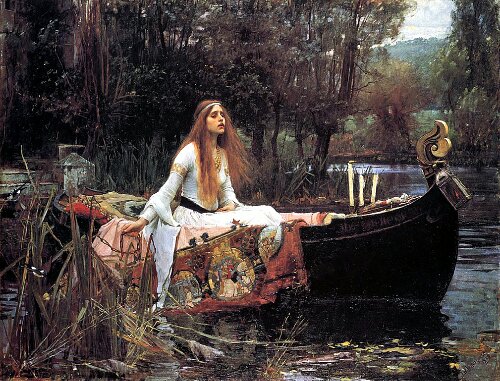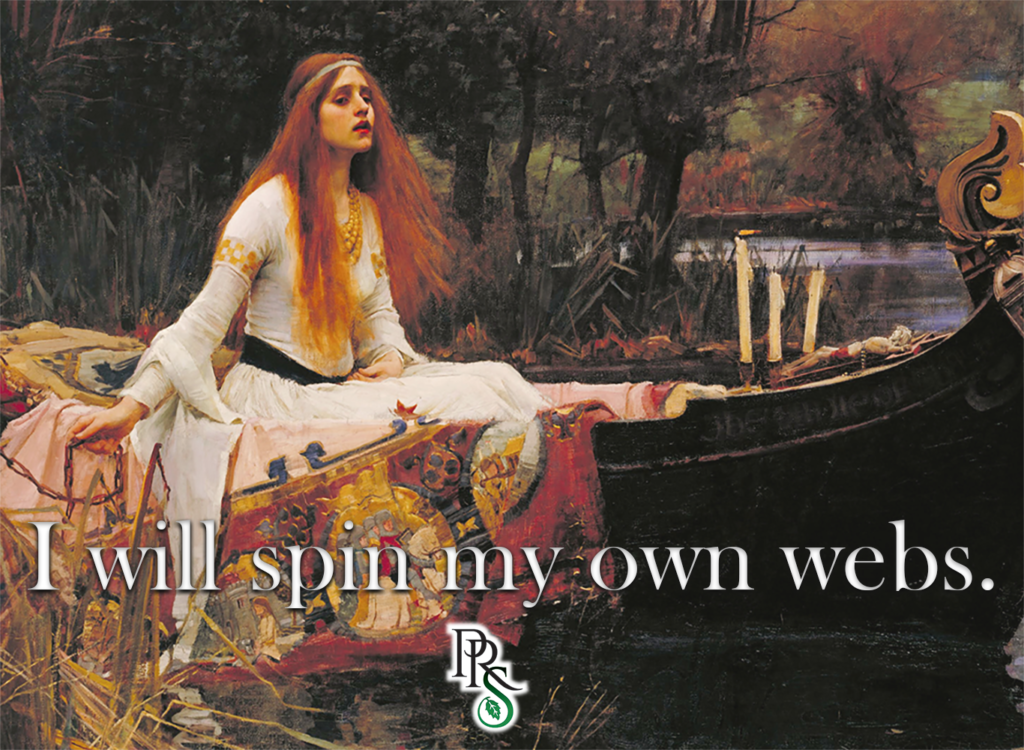
“The mirror crack’d from side to side;
“The curse is come upon me,” cried
The Lady of Shalott.“
Forbidden from interacting with the world, Tennyson’s Lady of Shalott lives a life of solitude, spending her time weaving elaborate tapestries as events of the world are reflected to her through a mirror.
Our modern eyes may read The Lady of Shalott and the Pre-Raphaelite paintings it inspired in a way vastly different from the artists’ intent.
Outside the constructs of 19th century society and far removed from the Victorian patriarchy, we no doubt experience the work differently, but are we so removed from it?
We still experience a certain degree of separation. Books written for and by women are often described as “chick lit”. Separate labels exist for “women directors”, “women writers”, “women artists”. Even the way we view aging is skewed against females: an older woman may be described as haggard, while a man is described as distinguished.

I recently read a Twitter thread that skewered The Lady of Shalott because she is shut away and is expected to spend her life weaving. If you feel outraged on behalf of The Lady of Shalott, it is because you’re supposed to. The lady is cursed, alienated, isolated.
Should we isolate her further by ignoring her and treating Tennyson’s work as an archaic representation of women? Or can it be an inspiration?
The lady’s curse comes whispered to her from an unknown source. Perhaps our form of the curse has been whispered to us so subtly that we hardly recognize it, so firm is its foothold in society – it has seeped into our subconscious, telling us to focus on looks and glamour over brains and intellect.
Instead of shadowy figures in a mirror, our curse is the repetitive images of the ideal body type and the misguided perception that as women, we should pursue what society dictates as opposed to whatever it is that makes each individual woman happy.
As long as the lady of Shalott remains in passive seclusion, she is allowed to live.
Once she actively makes her own choice to break free, the result is death.
Since girlhood we are taught to not rock the boat, to stay politely and quietly in the background. Many women still do, never learning to speak up for themselves or simply say no because they have this sense of dread. The lady’s death may have been literal, but often we fear a social death. If we forge our own path, someone may not like us.
The poem tells us that despite her curse, in her web she still delights. We have our own complicated 21st century web, a tangled skein of instagram filtered selfies, reality television, and social media influencers.
Our society has morphed into a world that craves likes, shares, and clickbait.
If we’re not careful we can become ensnared in that web, not by the invisible fictional curse of The Lady of Shalott, but by a variety of very real dangers such as social media addiction, online predators, body dysmorphia, or simply missing out on real world experiences because we are glued to our screens.
I see a concerning parallel between our screens and the lady’s mirror.
There is no shame in embracing The Lady of Shalott as a symbol to boost your own strength – to stand resolutely and say ‘I will break my own mirrors.’
Tennyson may have been using The Lady of Shalott as a commentary on the role of women in society or he may have been exploring the isolating experience of artist’s devotion to creation instead living their life.
There are multiple ways to interpret the poem, but I like the idea of using the poem to inspire modern women to have the courage to spin our own webs, inspired by our own self-worth and aspirations instead of mere reflections of what society tells us to be.


hear hear! well written!
Brilliant. I think you are right on, and you stated your point with intelligence and grace.
brilliant commentary and so true.
Everything you have written here resounds within me.
Dear Stephanie
Thank you for a thought provoking post. Women’s lives have changed radically over the last century, but there is still a long way to go throughout the world. Women are not second class citizens, nor should they be treated as goods and chattels, but sadly, this is still the case, and more sadly, if they try to break free, death can still be the result. Here’s to those incredibly brave women who do ‘break their mirrors’.
Best wishes
Ellie
I love this interpretation. The first time I heard of the Lady of Shalott was in Anne of Green Gables–the book and the movie. Do you remember the scene when she is quoting the poem and ends up floating down the river in a leaky barge? That was my introduction to the poem. 🙂
Is that the one with Megan Follows? That’s my favorite one.
Me too–I was obsessed with the movie and books when I was in junior high. 🙂
Thankyou, now I want to find that scene!
Really great post especially the sentence “If we forge..” that one’s going in my quotes notebook, Stephanie!
I enjoyed and followed this beautiful blog silently over the years, but now I must come out and congratulate for this great post.
I’ll never see the Lady of Shalott with the same eyes again.
Thank you so much for this brilliant analysis.
Maybe this can be your next T-shirt: an image of the Lady and the tagline, “I will break my own mirrors.”
I would wear that brilliant!
I’d wear that in a heartbeat!
This may be my new favorite PRS post. <3 The curse takes many forms; thank you for so clearly defining a very relevant one!
Wonderful post! I have mixed feelings about the curse. As an embroideress and weaver, the thought of having nothing else taking up my time but my crafts is rather appealing, not a curse at all. Yet, to only see the world through reflections, to be isolated, well, again, there are times, many times, when I wish for such solitude. Of course, to have no choice, yes, a curse indeed.
As someone living with chronic illness and disability I do think of The Lady of Shalott can be read as a description of life lived within the sorts of limitations and frustrations that illness can create. It also says something to me about how society views a life lived within those limits as having no worthiness and impossible of creating/contributing anything – her weaving has no value and represents nothing.
I love this interpretation of the poem. Break your mirrors, see the world with your own eyes. And I dare to take this a little further still. Perhaps, as you say, the curse may be to die socially, but can’t Death also be interpreted as a deep change? Perhaps The Lady of Shallot’s death could be interpreted as the death of her old self and the birth of a new one, capable of having her own perspective and opinions. Just a thought.
Oh, I like that. A death of an old version of yourself, leading to a new phase of your life perhaps.
I was amazed and delighted with your interpretation of the poem. Excellent, thank you for this.
Fascinating and inspiring interpretation! However, I suppose you could look at it this way – the woman is in her tower, creating an amazing work of art – the tapestry. But she throws it all away due to her attraction to a man. A different feminist response would be to say to women – don’t sacrifice your art (whatever it is) for love/romance? I think I prefer your interpretation!
If as a male, I may be permitted to comment….
In my mind sir lancelot is no more free than the lady of shalott. Both are forced to weave the expectations of the society they live in.
To do otherwise is to be condemed to a form of death – to be expelled from society to be no longer considered to be living.
To be aware that you would live a different life to one of the lives society allows is to be cursed.
Thank you, that was very insightful, Fred!